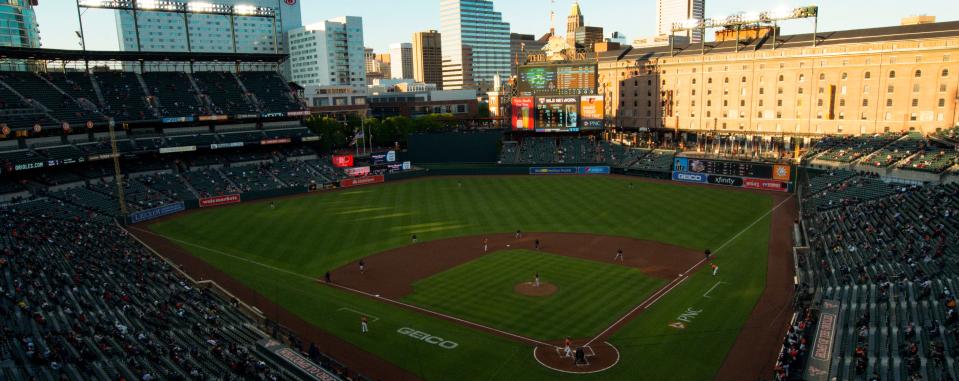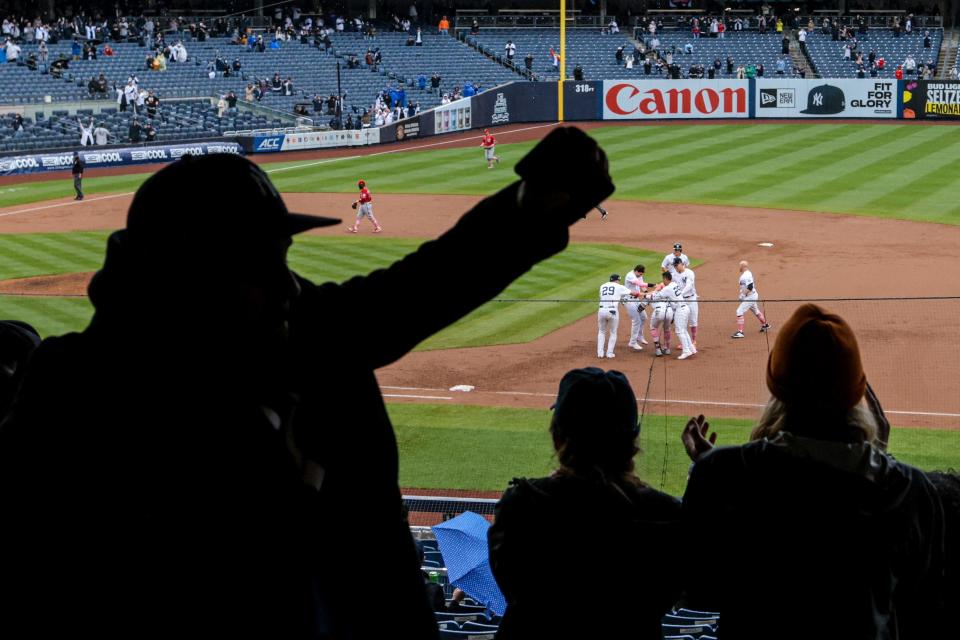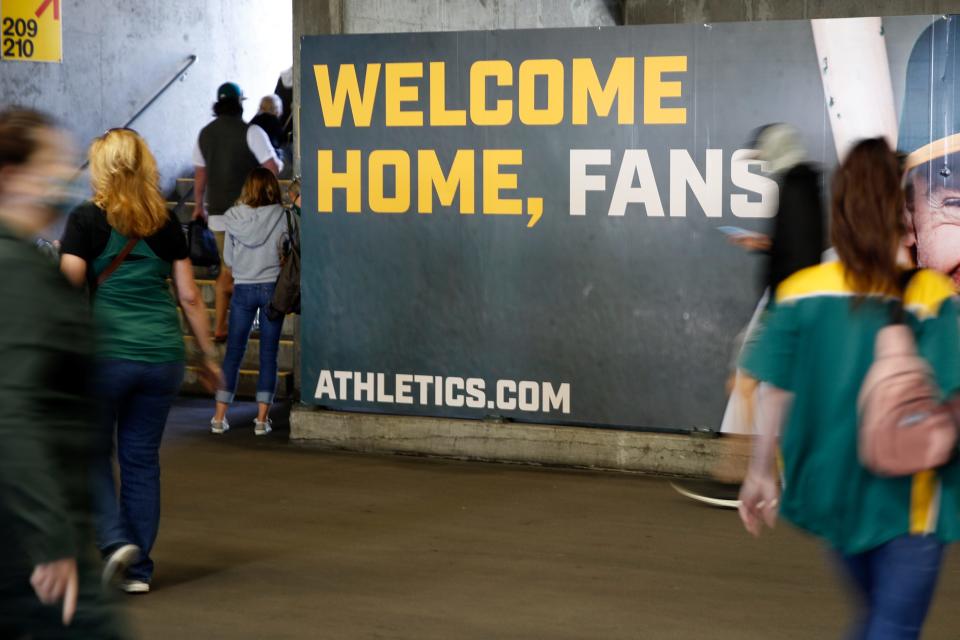MLB teams plan to fully reopen stadiums soon — but are fans ready to come back?

After two seasons in which the COVID-19 pandemic ravaged its industry and separated its games from its most passionate fans, Major League Baseball is finally nearing the point where the rhythm of the season and its ability to welcome fans intersect.
As the weather warms up, vaccination rates soar and positive case loads are flattening in most regions. As schools get ready to spring its students and staff for the summer, state governments and municipalities are loosening restrictions, many giving the green light for teams to soon host games at full capacity.
Now, in what we might call the In-Between Times for sports and entertainment, fans and teams alike are poking their heads outside and pondering the COVID effect: Are we ready to come back?
More alarmingly, are a certain subset of fans gone for good?
As teams shift on the fly from partial to something resembling full attendance, the remainder of the 2021 season may not provide all those answers.
For now, it is a matter of baby steps.

“Coming off of fake crowd noise and that soulless environment that we had in 2020, it’s a breath of fresh air,” Minnesota Twins president Dave St. Peter tells USA TODAY Sports. “I think there’s a tremendous amount of pent-up demand from the fan base – probably the hard-core fan that couldn’t wait to get back to the ballpark. People are excited to have a night out, to be with their loved ones, to have a cold beer and cheer on the hometown team.
“At the same time, we recognize there’s a subset of fans who aren’t ready to come back.”
MLB 2021: No-hitters remain amazing - but offensive futility can't be ignored
OAKLAND: Could Nashville be the Athletics' future home?
In an increasing number of markets, there will be few, if any barriers to their return beyond mask mandates and other local guidance.
In Minnesota, Gov. Tim Walz announced on May 6 a loosening of restrictions that would enable full capacity (39,500) at Target Field, which had been limited to 27% capacity, or around 10,600. St. Peter says the Twins are planning a “phased ramp-up” to 60% capacity for the remainder of May, 80% in June and then full capacity in July.
The St. Louis Cardinals on Tuesday announced they will double capacity – from 32% to more than 30,000, beginning May 21. Saturday, the Milwaukee Brewers will double capacity at American Family Field from around 12,000 to nearly 25,000, with full capacity by June 25. The Phillies on Thursday announced a move to 100% capacity on June 12.
Even the markets that were most restrictive through much of the pandemic are loosening.
Starting May 21, the Washington Nationals will increase from 25% capacity to 36%, a bump to nearly 15,000, and will be allowed full 40,000-fan capacity beginning June 11. The Mets and Yankees, by May 19, are cleared for 100% capacity among vaccinated fans and 33% for non-vaccinated, a bump from the 20% that enabled capacity of around 10,000 at Yankee Stadium and Citi Field.
Others will be full-go even sooner - the Diamondbacks, capped at 20,000 fans since the season started, announced they will allow full capacity beginning May 25, joining the Rangers and Braves.
Yet how often will the Diamondbacks – and teams in many markets – truly pack the house?
Even before the 2020 pandemic shuttered the industry, MLB attendance had fallen three consecutive years. With many teams giving season-ticketholders the choice to opt in or out of partial-attendance games, and the untold economic impact of the pandemic on pocketbooks, several markets have fallen well short of even their modest, reduced capacities.
Through 14 home dates, Arizona is averaging just 10,300 fans, barely half of capacity and just a blip in the 48,000-seat venue. The Oakland Athletics capped capacity at 26% (12,188), yet are averaging 5,520 fans through 23 dates, or 45% of capacity, and have drawn seven crowds of 3,600 or fewer fans, with a low of 2,893 on May 5.
Those that do attend are getting a unique ballpark experience – the company of fellow fans, but a tempered camaraderie. The freedom to cheer, at a distance.
They are also getting a glimpse of the future.
Touchless times
MLB has for years hoped to reach younger audiences, but the 2021 season so far has not been ideal to do so. Diminished capacity means restricted access to tickets, curbing the spontaneity of attending a ballgame, and the crowds at games seem to generally skew older.
For now, the average fan looks a lot like Bill and Cindy Lesser, retired empty-nesters and longtime Nationals fans who in recent years downsized to a condo on D.C.’s Southwest waterfront.
Their residence overlooks a performing-arts venue now serving as a public vaccination site. They enjoy peering out their windows and seeing doses administered, knowing each one brings the world closer to normalcy.
“We wave, we cheer and it’s so wonderful,” says Cindy Lesser, who along with her husband is planning a trip to visit their first grandchild, born Dec. 30 in California. “We can’t wait and I’m going to cry.”
On this day, they sip beers and cheer passionately, Cindy clad in a Capitals jersey and Bill in a Harmon Killebrew Washington Senators t-shirt, and appreciate fandom, 2021 style.
They are grateful the ushers urge mask vigilance. They can’t help but notice the cleaner restrooms and concourses. And Bill, ever the aging father, even managed to order contact-less concessions just minutes before he caved in and called one of his kids for tech support.
It’s different. But not terrible.
“I don’t mind some of the sterilization and cleaning process, which I hope would stay, frankly,” he says. “I’ve been going to baseball games for many years and sometimes the facilities aren’t that clean and people are coughing on each other. It’d be nice if the facility had more things that were touchless, that probably should’ve been done earlier. The technology is catching up.
“You know what? It’s not so bad to order the food (from the seats) and then go pick it up as opposed to get in a line, stand there and text each other, asking, ‘How’s the game going? I’m still in line.’”

Yet reduced capacity – and a dearth of fans showing up – can leave attendees feeling a little empty, as if to wonder, where is everybody?
Chuck King, who has been attending Arizona Diamondbacks games since 2003, will take excitement over elbow room any day.
“Nothing outweighs the full experience,” he said before a Wednesday night game played before an announced crowd of 5,714 at Chase Field. “Sure, you got a couple of seats between you and someone else, and nobody is fighting for the arm rest like on an airplane.
“But the real true benefit is there’s nothing better than turning around and giving somebody a high-five when your team hits a home run or some sort of phenomenal play. Baseball brings people together, sports do, in general.”
MLB is banking heavily on that. In an era when the in-home experience – from size of TV to broadcast access to cheaper food and drink – has perhaps become too alluring, the impetus to create a “ballpark experience” as opposed to luring folks into a stadium to watch a game will only grow.
Strangely, adapting to the pandemic may have forced teams to unwittingly improve the aesthetics of a night at the ballpark.
Clean living
Since his job depends on packing the house, St. Peter sheepishly admits that yes, many fans that have made it to Target Field don’t hate the reduced-capacity vibe.
“We’ve actually had some of our long-term fans say as much as they love Target Field full, they like it better with only 10,000 fans,” he says. “They don’t have lines. Egress and regress are easier. Parking is easier – all the things that come with reduced capacity. We let them know we appreciate their feedback but also want to get back to full capacity as soon as we can.
"There’s nothing quite like being in a ballpark that’s full. And that energy, we haven’t experienced it yet.”
Attracting and retaining customers going forward will in part depend on ballpark operations running as smoothly with 40,000 fans as it does with 10,000.
To that end, St. Peter anticipates many pandemic workarounds to become permanent.
Some may chafe the hardest-to-adapt fans - like mobile-only ticketing or cashless concessions. Others will benefit both workers and fans – such as the plexiglass partitions to cut down on transmission and ostensibly keep everyone healthier.
And who doesn’t prefer a clean restroom?
“We’ve always been proud of Target Field for our cleanliness and our staff,” says St. Peter, “but now there’s a new level of cleaning, a new level of safety around the cleanliness of the facility that’s here to stay.”
Now, to lure the fans.
It’s incumbent upon franchises to, as St. Peter puts it, “differentiate the gameday experience,” though much of that may have to wait until 2022. Even at full capacity, many parks will still retain socially-distanced sections for fans seeking greater safety at this stage of the pandemic.
For everyone else, the benefits of Baseball, 2021-style will be enjoyed with an eye toward normalcy, even with its inconveniences.
“Parking is easy. You’re not crowded up against people,” says John Murray, a 68-year-old Diamondbacks fan with a half-season ticket plan. “You can put your feet on the seat in front of you. That’s sort of the good news.
“I’d rather be complaining about the traffic, but it’s going to be nice to get rid of these stupid masks.’’
Contributing: Bob Nightengale in Phoenix
This article originally appeared on USA TODAY: MLB stadiums ready to fully reopen – but will fans come back?

